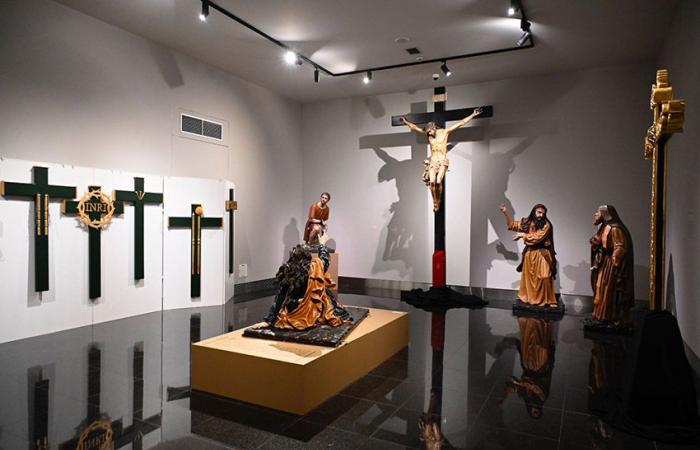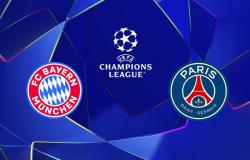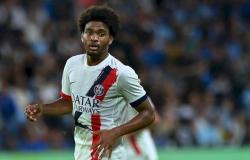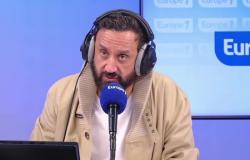Bishop Luis Ángel de las Heras inaugurated this morning the Diocesan and Holy Week Museum of León as a project of “cooperation and hope, which brings together the contributions of public institutions, the Junta de Castilla y León, the Provincial Council and the City Council, brotherhoods and brotherhoods , individuals and the Diocese, all of which constitutes a cooperation that gives hope and that transmits a message of strength and unity, without losing the uniqueness of the contributions of each person and each institution and, yes, freeing ourselves from interested and fruitless particularisms.”
DIOCESAN IMPULSE
A new museum space that is now a reality and has its origins in the impulse that the then bishop Julián López gave to the diocesan commission in 2014 to “create a museum that is a faithful exponent of the religious manifestation of Holy Week.” , in a project that Bishop Luis Ángel has highlighted as an expression “of the Christian communication of goods between the brotherhoods and brotherhoods and the Diocese of León at the service of the common good, which is equally hopeful and calls to new collaborations, to walk together towards the future with hope.”
This inaugural event of the Museum took place in the central glass cloister, around which the eight exhibition rooms of the historic building of the Major Seminary are arranged, at whose main entrance on Mariano Domínguez Berrueta Street, Bishop Luis Ángel, together with the Mayor of León, José Antonio Díez, the president of the Provincial Council, Gerardo Álvarez Courel, and the Minister of the Environment of the Government of Castilla y León, Juan Carlos Suárez-Quiñones, have discovered a plaque commemorating the inauguration. The president of the Holy Week Mayor Board, Diana Belén García, has been in charge of leading the event that was attended by the bishop emeritus of León, Julián López, the president of the Cortes of Castilla y León, Carlos Pollán, the Attorney General, Tomás Quintana, the delegate of the Junta de Castilla y León, Eduardo Diego, as well as civil and military authorities.
FAITH AND LIFE
In addition to highlighting the binomial of cooperation and hope as signs of this new Diocesan and Holy Week Museum, Bishop Luis Ángel also wanted to place special emphasis on the binomial of faith and life to point out that “this incomparable space keeps and offers treasures of centuries of Christian faith, splendidly expressed in sacred art and Holy Week as an inalienable part of the history of León, a history in which faith and life have been and are united. And as a result of this unity of faith and life, the rooms make visible the beliefs, devotions and admiration of human beings before the mysteries of the Christian faith and transport the visitor through the beauty of sacred art to the knowledge of God who loves humanity. Humanity and wants the best for each of its sons and daughters, a certainty that helps us on the pilgrimage through this valley of tears, which is also one of laughter and smiles.”
By highlighting the richness of the “Legion artistic heritage that shines in this Museum,” the diocesan pastor wanted to make a call so that “from now on this will be a meeting space to forge social friendship, Christian fraternity, and delve through the art in the amazement and knowledge of the mysteries of God, in this new museum and exhibition space that allows those of us who live and believe to frequent the future with hope, making a pilgrimage in the city and in the Diocese of León and everyone who visits us.”
“CONGRATULATIONS!”
“Congratulations, today and always, in this Diocesan and Holy Week Museum, which is inaugurated on this day!” were the words with which Bishop Luis Ángel concluded his speech, an expression of joy that was reiterated by all the interveners, who like the mayor of León, José Antonio Díez, spoke of “the emotion that all the people of León feel at this time of opening, a feeling that I would like to be transmitted to all the visitors who are going to arrive at this house of brotherhood in which the legacy that generation after generation has come to us for more than five hundred years is recognized, the identity that forged the brotherhoods and brotherhoods of León as spaces for centuries-old ties where families united by faith, devotion and tradition.”
A MUSEUM, DOUBLE NATURE
“A living and open museum” as it was defined yesterday in the public presentation event to the media led by the president of the 'Diocesan and Holy Week Museum Foundation' and vicar general of the Diocese of León, Luis García, who has remarked that “it is a joy to be able to inaugurate this museum, a single museum with double nomenclature, with two natures, since it includes the representation of Holy Week and at the same time the art and popular piety of our communities and parishes in concomitance with Holy Week.” And in line with this dual nature, the work of the two co-directors, Alejandro Grande and Iván González, has also been highlighted, with a special message of gratitude that the president of the Foundation wanted to focus “on the penitential brotherhoods of Holy Week, which “They have generously donated their pieces so that we can enjoy them in a new way, in a different way than we usually can see them in a procession.”
“This Diocesan and Holy Week Museum, this house aims to combine the best and most representative of diocesan sacred art, with an emphasis on the concept of popular art that we want to defend and vindicate, with the great and rich heritage that the brotherhoods and brotherhoods have treasured over the centuries, in this house that we want to be the house of all the Papones and the house of the Diocese in its sacred art,” said co-director Alejandro Grande, who presented the campaigns of information, 'Friends of the Museum' loyalty and dissemination of the new museum already underway from the website www.mdyss.es and social networks.
From the scientific committee, Professor César García Álvarez indicated that the work “has been focused on the idea of achieving the most complete, balanced and profound representation possible of the heritage that the brotherhoods and brotherhoods have been treasuring over the centuries to celebrate the Passion of Christ, and in fact the chronological route of the Passion is the idea that structures the entire itinerary that unites the different rooms.” A journey through seven rooms, with introductory panels and sculptural groups that are accompanied by careful evangelical texts and posters that explain the theological, symbolic and artistic dimension of each work, in which professor Ariadna González del Valle has collaborated, who has insisted on “showing the importance of the passionate story, through pieces of imagery, goldsmithing, so that with the support of temporary exhibitions and other types of activities, a living museum is achieved, which during Holy Week “You live here all year round.”
To this journey through the Passion of Christ that articulates the first part of the museum discourse is added the diocesan room, with 226 pieces, in which works that were in the Diocese's warehouses are exhibited and that according to the person in charge Iván González “now They have had the right moment to be shown for the first time to the public and researchers, so that the heritage of the Diocese comes to light, with years of work carried out by a professional team of restorers, in a room that tries to explain how the Christian communities of the Diocese have lived those transcendental events of the Passion of Christ and how to bring the Christian fact closer to everyone.”
A museographic discourse in eight rooms that have all the resources of the museum, which occupies a part of the building of the Major Seminary of León around the south cloister, in control of temperature, humidity, access, to present sculptural groups without thrones that facilitate the approach to the pieces and special display cases for pieces of goldsmithing, embroidery and jewelry, and harmonized posters and signage that turn the Diocesan and Holy Week Museum into a unique and unified museum entity with which the Diocese of León advances in a project that was launched in 2014 when the then bishop Julián López created a commission to “study the possibility of creating a museum that is a faithful exponent of the religious manifestation of Holy Week” .
Fuente
Diocese of León






